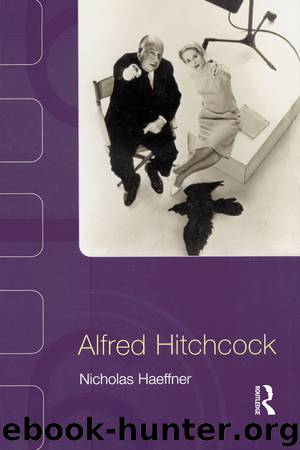Alfred Hitchcock by Haeffner Nicholas

Author:Haeffner, Nicholas [Nicholas Haeffner]
Language: eng
Format: epub
ISBN: 9781317874867
Publisher: Taylor & Francis Ltd
Here Hitchcock challenges the common-sense response of his audience who might be inclined to dismiss the story with its outlandish coincidences, as too far-fetched, even for fiction.
Given the explicitly negotiated contract with the audience in respect of The Wrong Man, it is worth considering more closely. Hitchcock made the film for Warner Brothers as a favour to the ailing company for no salary. It has similarities with other Warner Brothers ‘social problem’ films, such as I Am a Fugitive from a Chain Gang (1932), which also dealt with the ordeal undergone by a wrongfully accused man. Warner’s films frequently aimed for naturalism and, as in The Wrong Man, attempted to copy the shooting style of newsreels (as in The Public Enemy, 1931). The film was also made at a time when new lightweight camera equipment made shooting on location, rather than in the studio, much easier and more fashionable. The Wrong Man has been seen as one of Hitchcock’s most and least typical films. Rohmer and Chabrol described it as a film which ‘brings together the themes scattered throughout his work’ (1992, p. 145). The film refers back to I Confess (1951), in its theme of a holy innocent whose self-belief is tested to the limit on being wrongly accused of a crime. It also refers forward to Vertigo, Psycho and Marnie with its stress on madness. However, its semi-documentary visual style and lack of humour made the film seem atypical to Hitchcock audiences.
The Wrong Man is the most self-consciously realist of all Hitchcock’s films. Inspired by the true story of Manny Balestrero (Henry Fonda), who was wrongly accused of robbery, the film involved a labour of elaborate reconstruction in order to get as close as possible to actuality. Hitchcock told Truffaut that ‘everything was minutely reconstructed with the people who were actually involved in that drama. … We shot on the locations where the events really took place. Inside the prison we observed how the inmates handled their bedding and their clothes. … We also used the actual psychiatric rest home to which the wife was sent and had the actual doctors playing themselves’ (Truffaut, 1965/1986, p. 358). Members of the Balestrero family were also on set to ensure the authenticity of the film (Krohn, 2000, p. 180).
Furthermore, Hitchcock went to some lengths to evoke realism by abandoning the high-gloss surface finish which had characterised his previous American films such as To Catch a Thief (1954) and The Man Who Knew Too Much (1956). He hired cinematographer Robert Burks to shoot the film, warning him: ‘Perhaps you may not want to do this picture, Bob. I wouldn’t want the stark, colourless documentary treatment I expect to reflect on your reputation as a photographer’ (Deutelbaum, 1986, p. 214). Hitchcock had ‘emphasised that he wanted it shot like a newsreel shot’ (ibid.).
However, as Sterritt has pointed out, ‘Hitchcock changed the actual events of the Balestrero case in many ways, treating it not as an inviolable set of facts, but rather as a vehicle for exploring themes that interested him’ (Sterritt, 1993, p.
Download
This site does not store any files on its server. We only index and link to content provided by other sites. Please contact the content providers to delete copyright contents if any and email us, we'll remove relevant links or contents immediately.
Cecilia; Or, Memoirs of an Heiress — Volume 1 by Fanny Burney(32495)
Cecilia; Or, Memoirs of an Heiress — Volume 2 by Fanny Burney(31909)
Cecilia; Or, Memoirs of an Heiress — Volume 3 by Fanny Burney(31888)
The Great Music City by Andrea Baker(31756)
We're Going to Need More Wine by Gabrielle Union(19002)
All the Missing Girls by Megan Miranda(15769)
Pimp by Iceberg Slim(14433)
Bombshells: Glamour Girls of a Lifetime by Sullivan Steve(14020)
For the Love of Europe by Rick Steves(13525)
Talking to Strangers by Malcolm Gladwell(13288)
Norse Mythology by Gaiman Neil(13274)
Fifty Shades Freed by E L James(13185)
Mindhunter: Inside the FBI's Elite Serial Crime Unit by John E. Douglas & Mark Olshaker(9260)
Crazy Rich Asians by Kevin Kwan(9217)
The Lost Art of Listening by Michael P. Nichols(7452)
Enlightenment Now: The Case for Reason, Science, Humanism, and Progress by Steven Pinker(7272)
The Four Agreements by Don Miguel Ruiz(6697)
Bad Blood by John Carreyrou(6581)
Weapons of Math Destruction by Cathy O'Neil(6213)
